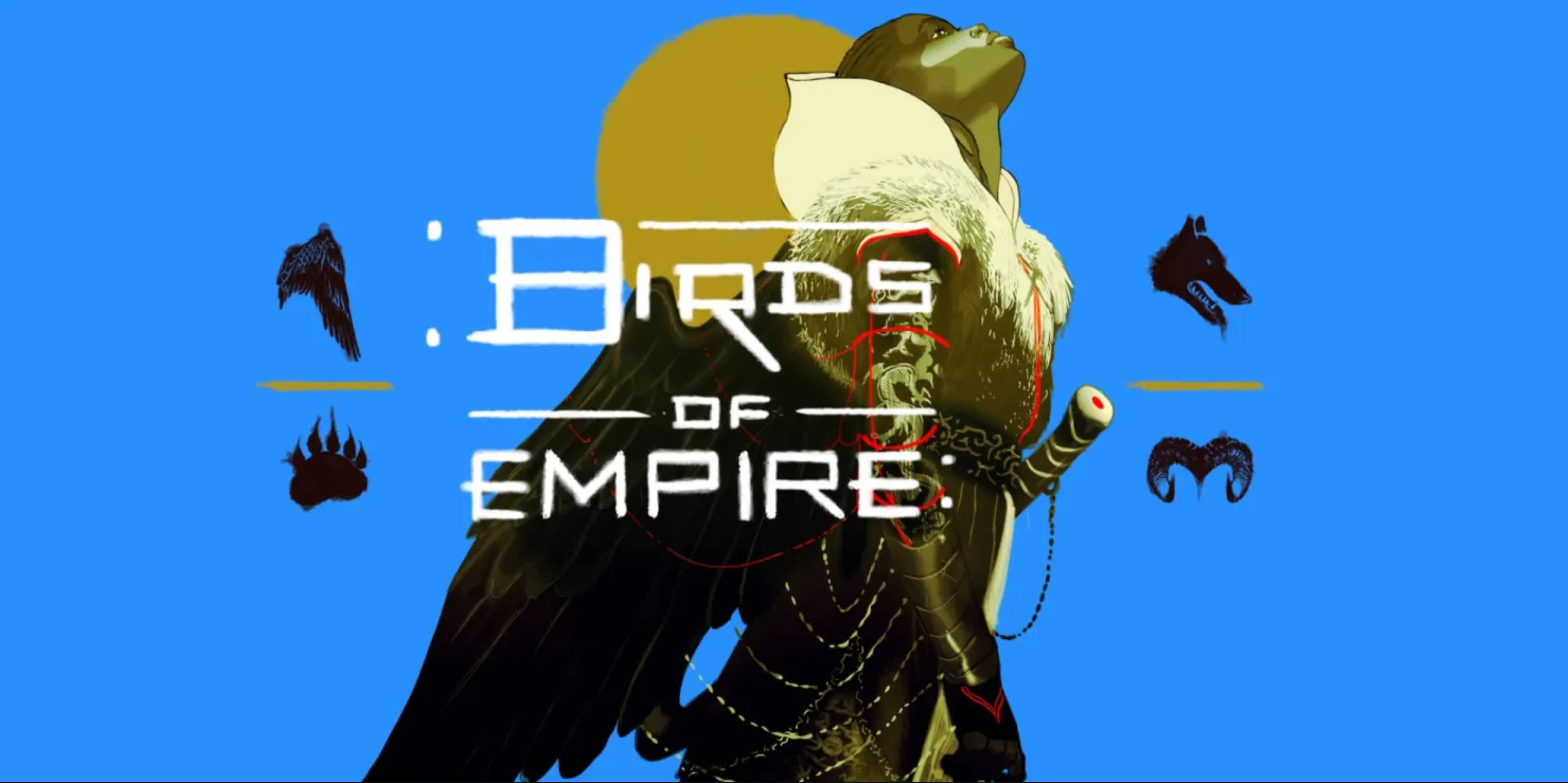Entertainment
Related articles:
I listened to Birds of Empire over the course of several kayaking sessions on Chautauqua Lake, surrounded by the kind of lush scenery and great outdoors the show seeks to immerse any listener in, regardless of where they are. Then, I listened to it again in a quiet room with the windows closed and my mixing headphones on. The experience was not, precisely, the same.
If you’re reading this review to learn whether or not you should listen to Birds of Empire, I’ll tell you right now that it’s a great show. The setup is Horizon: Zero Dawn meets Fallout: New Vegas’ “Honest Hearts” DLC with intricate worldbuilding and a premise – prehistoric tribal life in the very-post-apocalypse through the eyes of four young adults from each of the four different clans in New Dakota – that is bursting with potential for an epic tale of humanity rebuilding. I will always be excited for an original fiction podcast that markets itself on its own merits of craft and concept, rather than a pre-existing IP or celebrity stunt cast, and Birds of Empire deserves your support for that alone. Oh, and it’s a post-apocalypse “everyone is in tribes and has returned to a pre-colonial way of life” story with a principal cast entirely composed of people of color, which is very refreshing to see (top tip, if you’re going to use the aesthetics of Indigenous people from the Americas and Africa, it’s probably a good idea to make those individuals your main characters. Looking at you, Horizon).
All that being said, I’m not here to do a traditional review of this show. While doing my homework on the show’s development process and marketing, some words kept coming up: “immersive”, “cinematic”, and “premium audio”. We’ve talked before on this blog about what “immersive” means in an audio context, and how it’s been overused to the point of being divorced from its original meaning of a work using ambisonics or binaural audio, but what exactly makes a work of audio fiction “cinematic” when that word is specifically tied to the visual medium of film? What is “premium audio”, or at least how does this show define it? And most importantly: what does it mean for large production houses like QCODE to make these claims about their work, and does said work genuinely feel more “premium” than other productions in the same medium?
A big aspect of Birds of Empire’s marketing was that its sound designer, Randy Torres, has a resume that includes big-budget movies like Interstellar, Tenet, and Dunkirk. He’s worked on several other QCODE shows including Last Known Position and Cupid, but I wasn’t able to find any other podcast projects of his that were not done under this company. The sound design of all of these shows is certainly solid, but I had to wonder why a fiction podcast that was so eager to impress upon me the incredible quality of its sound design, was telling me about the movies that its designer had worked on.
Anyone who has worked in multiple mediums as a sound designer will tell you: they all require different skills. This isn’t to say that people can’t make the shift back and forth – I’ve taken on a number of projects in both live theater and fiction podcasting – but each medium requires different focuses and techniques. I can get away with things when designing for a five hundred-seat theater that I simply can’t when my work is going straight into a listener’s ears. Live sound is mixed very differently than post-produced, and even within that category, how we sound design for TV and film, and how we sound design for fiction and nonfiction podcasts, is separated by one key factor: information.
When you are sound designing for a medium with a visual component, you can be subtler, more abstract, more minimalistic. If you’re watching a cartoon, you won’t hear a sound effect for every single thing that happens on screen. A film can introduce a character silently standing behind the protagonist in order to achieve a certain effect, and if there is no audio cue to tell us that someone has entered the room, the audience won’t miss out on that information. You make different choices, prioritize different things, and troubleshoot different issues.
These experiences flow into each other and help create a well-rounded sound designer who can flex in various areas, but when I sit down to listen to a fiction podcast (especially considering that fiction podcasts as we think of them today are still relatively new compared to other mediums), I want to know that the sound designer in charge of it can seamlessly and accurately provide me enough audio information to draw me into the world and paint a picture in my mind.
Does Birds of Empire do that? Sure! I could understand the vast majority of what was going on in each scene, although the stylistic choice of a narrator was certainly necessary from a technical standpoint as well. The sound effects were well-placed; everything was panned comfortably; no voice actors sounded like they were recording in a cinderblock room. There was clearly a lot of care put into deciding the sound of this world, down to how it feels to listen to each of the four tribes’ home bases.
Would I call it a “cinematic fantasy event in audio”, though? No. Birds of Empire is a well-crafted, interesting show that scratches a particular itch in fantasy fans, but I cannot say that it does anything decidedly new or innovative in the medium. That’s fine, by the way! Not every show has to be The Goblet Wire or The Amelia Project in terms of finding new and weird ways to tell a story to your audience using the audio medium. However, when you use this kind of language in your advertising, I’m going to go in expecting to have my mind blown by a boundary-pushing project that inspires me to try something new in my own work. I didn’t feel that. I had a good time, enjoyed the atmosphere, then closed my podcast app and went to go cook dinner.
If you know me, you know that I am constantly talking about how the people I see pushing the boundaries of audio fiction are indie creators. Whether it’s shows like Archive 81 implying terrifying horror with the monster you’ll never see, Fawx and Stallion recreating the style and feel of stage farce in an audio-only format, or Badlands Cola proving that you don’t have to sacrifice psychedelic strangeness to tell a coherent story, when I want to listen to something fresh that challenges what I think we can do in this medium, indie shows are first on my list. I would argue that’s because they often have the creative freedom to take big risks and try new things, but studios like QCODE seem to want to do that as well – or at least their ad copy says they do.
So what’s stopping them? I recently spoke to a friend who works for a bigger-budget studio focused on audio fiction, and they told me that the desire to take advantage of the creativity found in the indie scene is certainly there. The issue, they explained, is that shows often need fast turnaround times in production, turnaround times that studios perceive indie creators are not used to. I would argue that this is because many independent creators only make enough money from their shows, if any at all, to treat podcasting as a side gig that comes second to their day job, but it’s understandable that the current model is to make a lot of different shows, one after the other, and see what sticks.
Are they sticking, though? If you appraise these shows through cultural impact alone, which is what I perceive their studios are trying to do in addition to ad revenue, and compare them to the buzz around many indie favorites like Greater Boston and The Penumbra Podcast, the fan fervor just isn’t there. Tatiana Maslany fans listen to Power Trip, enjoy a great show with their favorite actress, then move on to her next project. Fans of Girl in Space are still singing its praises nearly four years after season one ended.
The message seems pretty clear: indie creators, despite having markedly less money, time, and reach, are still leading the charge when it comes to pushing fiction podcasts to new audiences and forward as a medium. Come with me on the journey I went on through the “podcast recommendations” tag on Tumblr, and count how many big-budget shows you see. Then count the number of indie shows. It’s a pretty big gap.
All of that being said: a rising tide lifts all ships. We should have big budget productions that succeed and do new and innovative things, because like it or not, money is the entertainment industry’s biggest legitimizer and more fiction podcasts being made with higher production rates is a good thing. Quiet Part Loud is a great example of this: from indie veteran Mac Rogers, to the Emmy-award winning Marcus Bagala, Monkeypaw Productions picked people who knew not just how to specifically craft a story in audio, but had the industry experience necessary to know how to push those creative boundaries (and Bagala, for the record, also does work in TV and film). It’s been praised to high heaven by fans and critics alike, and created buzz among people who have been working in fiction podcasts since they were barely a twinkle on Spotify’s radar.
Shows that genuinely move the medium forward, create event releases, and do big things with audio can be made by larger studios, and I think QCODE certainly has the resources to do it. Birds of Empire has a fascinating premise with so much room to get weird and try new techniques in the world of sound design. If QCODE chooses to make a second season, I really think there’s an opportunity to make it the boundary-pushing tentpole they advertise it to be. But my first flag that this show wasn’t going to live up to all of its hype was when I saw it described as “cinematic”. If I wanted cinema, I’d go watch a movie. If I listen to a fiction podcast, I want it to be proud of the medium it’s using to tell that story, because that means it’s going to utilize the opportunities of said medium to the fullest.

